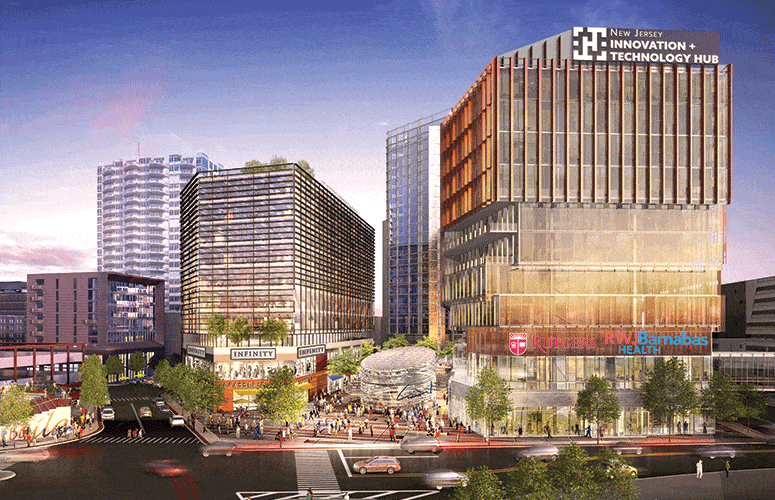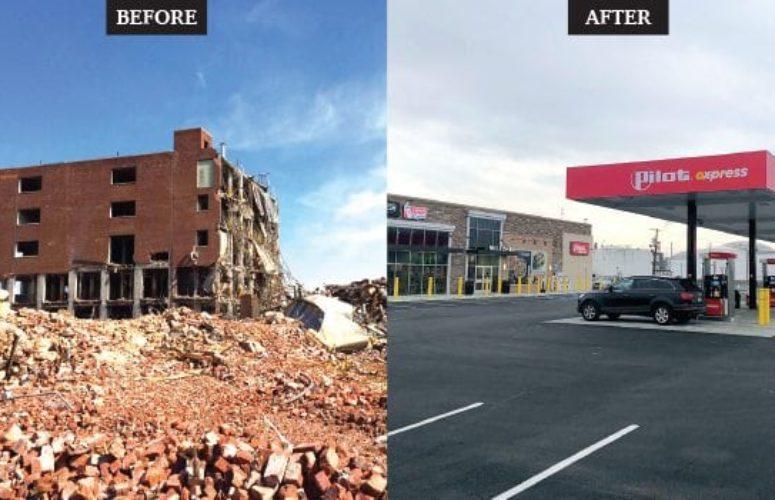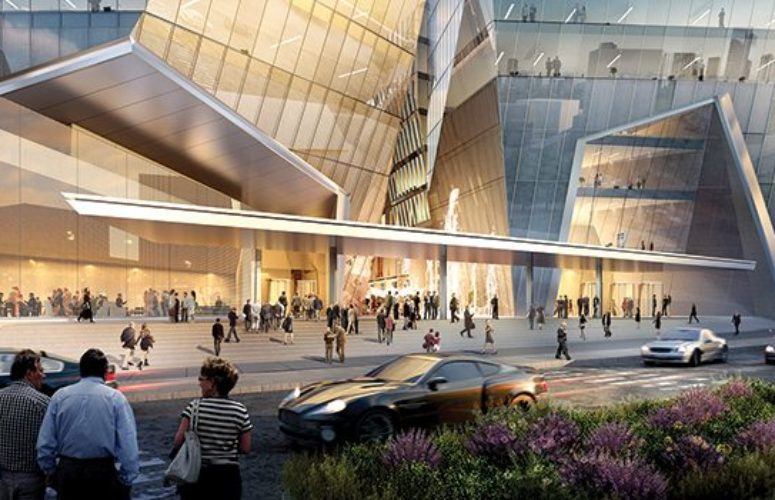
New Brunswick: The Heartbeat of Middlesex County
The healthcare, higher education and cultural center of the Middlesex County, New Brunswick continues to forge a path of innovation on a variety of fronts.
By Lisa Goulian Twiste, Contributing Writer On Jul 7, 2021If you’re looking for the beating heart of Middlesex County, you’ll probably find it somewhere in New Brunswick, home to New Jersey’s largest institution of higher learning, Rutgers University, as well as Rutgers Robert Wood Johnson Medical School, two major hospitals – Robert Wood Johnson University Hospital and Saint Peter’s University Hospital – and one of the world’s largest healthcare manufacturers, Johnson & Johnson.
Known for its diverse population, multicultural downtown vibe and a growing arts community, New Brunswick is also the site of several ambitious business initiatives developers are hoping will solidify the city as a hub of medical scientific research in New Jersey and the Northeast.
All told, projects valued at $1.45 billion are being developed by the New Brunswick Development Corporation (DEVCO) in partnership with Middlesex County, the New Brunswick Board of Education, and others.
Leading the way are the Rutgers Cancer Institute of New Jersey (RCINJ) Cancer Pavilion, a state-of-the-art, free-standing extension to the current facility with inpatient and outpatient services, research laboratories, retail space and ancillary services; and the New Jersey Innovation and Technology Hub – called the “Innovation Hub,” for short – a new collaborative center that aims to foster research, entrepreneurship, innovation and startup incubation, with Rutgers University, Hackensack Meridian Health, RWJBarnabas Health and Princeton University as its core partners. Both of these projects are expected to open in 2024.
“What’s really important about all of this is that, in some ways, New Brunswick is reclaiming itself as the epicenter of innovation, not only in New Jersey, but in the region,” says Chris Paladino, president of DEVCO, who has developed projects worth more than $1.4 billion in New Brunswick since 1994. “The site of the Hub is where Thomas Edison and the Johnson brothers of Johnson & Johnson (J&J) would meet for lunch at the pharmacy counter to discuss technology and manufacturing innovation, and just a few blocks away is where Dr. (Selman) Waksman did antibiotics research that earned him the Nobel Prize, turning Rutgers into a true research university.”
A NEW AGE OF HI-TECH COLLABORATION
Construction was scheduled to start last month on the Cancer Pavilion. It will be a 12-story, 510,000-square-foot structure that will include a full floor of operating rooms; radiation, oncology and chemotherapy services; and CT, PET and MRI scan technology services. Developed in partnership with RWJBarnabas Health, the Pavilion will connect to the current RCINJ building on Little Albany Street and Robert Wood Johnson University Hospital on the site of the old Lincoln Annex School. The new Blanquita B. Valenti Community School, part of the project, is under construction four blocks away on Jersey Avenue.
These projects represent $1.08 billion breaking ground this year, with the remaining $300 million breaking ground by September 2022, according to the Middlesex County Office of Business Engagement.
“Between the Blanquita B. Valenti Community School and the Cancer Pavilion, there will be a significant number of construction jobs immediately, and once the Cancer Pavilion is completed, there will be a significant number of highly skilled professional jobs, such as doctors, nurses, X-ray technicians, lab technicians, and many others,” says Steven Libutti, MD, FACS, RCINJ director and senior vice president of oncology services for RWJBarnabas Health. “This should lead to new start-up companies and collaborative opportunities within the industry, and is going to further our position as a hub for cancer research and patient care in New Jersey.”
This summer is also when construction is scheduled to start on the Hub’s four-acre, 1.7-million-square-foot mixed-use complex, offering a 235,000-square-foot Innovation Center with modern workspaces designed to foster collaboration among researchers, entrepreneurs and startups, and 90,000 square feet of retail space. This past November, Governor Murphy called it “a major step in helping New Jersey reclaim its spot at the top of the innovation economy,” as he announced the first tenants as Princeton University, Rutgers University, Hackensack Meridian Health and RWJBarnabas Health.
“What we’re creating with the HUB is an ecosystem where creative collisions can take place, where ideas go from the lab bench, to a small company, to a generator of employees and eventually an initial public offering,” Paladino says. “Also, this investment in research innovation and world class healthcare will attract financial technology and insurance companies, law firms, large accounting firms, and others to New Brunswick.”
The good news for perspective employers is that not only does New Jersey have more engineers, PhDs and research scientists per capita than any other state in the country, but a vast majority of them live within 20 minutes of New Brunswick, Paladino says. The area has benefitted from an influx of immigrants from across the globe, including China, India and Ireland, adding to the area’s already rich talent pool.
“That’s how ideas are born; that’s how companies grow; that’s why companies relocate: because of access to talent,” he says. “And in New Brunswick, we don’t have to try to build an urban lifestyle; it’s here. We have great restaurants, apartments and condominiums, performing arts centers, over 600 first class hotel rooms and conference centers – all of which support this type of development.”
RUTGERS A MAJOR DRIVER
When Rutgers University is in full swing, students, faculty and visitors spend $3.5 billion annually, generating $5.2 billion in economic activity for New Jersey – the vast majority in the New Brunswick area. This includes more than $60 million in purchases from New Jersey companies, including everything from coffee shops, to IT services, to eco-friendly cleaning and floor care products. There’s a daily influx of more than 10,000 faculty and staff members, as well as academic conferences, faculty meetings, and special events leading to significant revenue for local hotels, restaurants, conference centers, and catering facilities.
“Rutgers has long been a driving economic force in Middlesex County and throughout the region,” says Peter J. McDonough Jr., senior vice president for external affairs at the university. “In addition to the more than 50,000 students, faculty and staff who learn and work at Rutgers-New Brunswick, our discoveries have fueled the innovation economy, our construction investments have created thousands of jobs, and our commitment to working in partnership with political leaders has built an economic foundation unlike any other in New Jersey.”
Rutgers has been steadily gaining prestige over the last decade, especially with the integration of the University of Medicine and Dentistry of New Jersey in 2013, joining the Big 10 in 2014, and, more recently, for scientific breakthroughs made at the university during the pandemic, including the saliva test developed by the late immunologist and Associate Research Professor Andy Brooks.
“Rutgers has continued to demonstrate power and impact in the bio-medical space,” Libutti says. “I think with all that has occurred – all the investment in new facilities, two medical schools, the Pharmacy School, the Dental School, the School of Health Professionals and the School of Nursing, to name a few – it will attract students from all over the country and the world who want to train at these facilities and who we will have for recruitment opportunities once the Cancer Pavilion is completed.”
In fact, the entire city of New Brunswick – including businesses, restaurants, shops and stores – has gone through incredible growth in the last 10 to 15 years, with the crowning achievement being the two major DEVCO construction projects and what they say about growth in the health and bio-tech space, according to Paladino. Fast forward to 2024, and he anticipates 10 new investigative teams bringing millions of dollars in oncology research to the Cancer Pavilion, and 150 to 200 companies established in the Hub, employing 500 to 600 people.
“We are truly on the verge of a new era of discovery and extraordinary economic growth, as ideas become companies and companies become major employers in the region,” he says. “I think it will be one of the most exciting eras in New Brunswick’s storied history.”
To access more business news, visit NJB News Now.
Related Articles:





